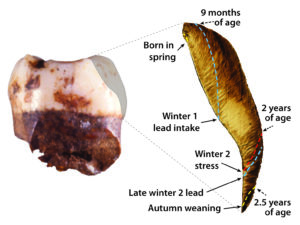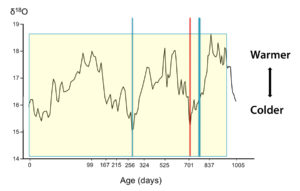
By analyzing teeth of two 250,000-year-old French Neanderthals, scientists have shed light on the seasons when the Neanderthals were born, as well as on their weaning trajectories and their exposure to extreme climatic stress. The study also reveals the oldest documented exposure to lead in hominin remains. Together, these results show direct effects of climate on the growth and development of our ancestors in the distant past, important for understanding human evolution. Experts have long attempted to reveal the relationship between human evolution and climate change. Although environmental variability, such as extreme seasonal cold, is believed to have strongly influenced human evolution, it has proven very difficult to directly measure because of the coarseness of standard analytical methods. In a novel use of oxygen isotope and trace element analysis involving micro-sampling of tooth enamel from two Neanderthal individuals and one modern human from an archaeological site in southeastern France, Tanya M. Smith and colleagues investigated relationships between patterns of seasonal variation and Neanderthal life history. Oxygen isotopes in the approximately 250,000-year-old Neanderthals display multiyear patterns indicating winter and summer seasons, analysis of which suggests the Neanderthal individuals experienced cooler winters and otherwise more extreme seasonal periods compared to the more recent modern human from the same archeological site. This led to childhood development stresses during wintertime in the former, the authors say, based on further analyses. One of the Neanderthal samples shows elevated barium levels until nine months of age, consistent with nursing through that time, the authors say. It appears this individual was born in the spring and weaned in the fall around two and a half years of age, which is in line with the pattern in most mammals that give birth during times of increased food availability. Additionally, the researchers found evidence that both Neanderthals were exposed to lead at least twice in their early life. This represents the oldest documented exposure to lead in hominin remains, they say.
______________________________

Photograph of one of the Neanderthal children’s teeth. © Smith et al.
______________________________

A 250,000-year-old Neanderthal tooth yields an unprecedented record of the seasons of birth, nursing, illness, and lead exposures over the first three years of this child’s life. Tanya Smith & Daniel Green
______________________________

A 250,000 year-old Neanderthal tooth yields an unprecedented record of the seasons of birth, nursing, illness, and lead exposures over the first 3 years of this child’s life.
Smith et al. 2018 Science Advances
______________________________
Article Sources: AAAS Science Advances and CNRS news releases Science Advances is published by AAAS, the nonprofit science society.





